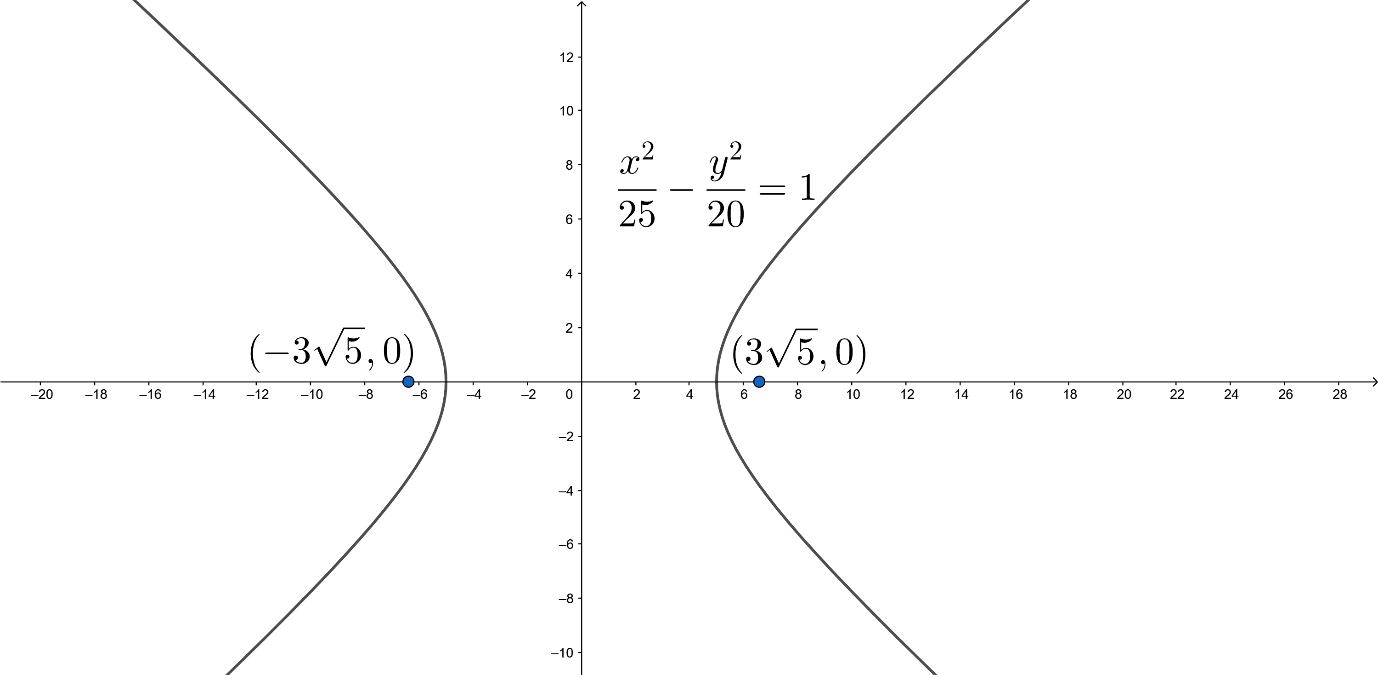
Find the equation of hyperbola (with a diagram) that satisfies the given conditions: foci $\left( \pm 3\sqrt{5},0 \right)$ & length of latus rectum is 8 units. Find the eccentricity of the above hyperbola. Find if $\left( -1,2 \right)$ lie on the hyperbola or not?
Answer
572.7k+ views
Hint: We are given a hyperbola whose foci is $\left( \pm 3\sqrt{5},0 \right)$ and length of latus rectum is 8 units. Since the x-coordinate of foci is 0, therefore the focus lies on the x-axis. Hence, the equation of hyperbola will be in form of: \[\dfrac{{{x}^{2}}}{{{a}^{2}}}-\dfrac{{{y}^{2}}}{{{b}^{2}}}=1\], where a > b. So, we need to identify the values of a and b for getting the equation of hyperbola. As we know that foci is represented as $\left( \pm ae,0 \right)$, where e is the eccentricity given by \[e=\dfrac{\sqrt{{{a}^{2}}+{{b}^{2}}}}{a}\]. Also, the length of the latus rectum for hyperbola is given by: $\dfrac{2{{b}^{2}}}{a}$. Get the value of b in terms of a and put in the eccentricity to get a quadratic equation of a. Now, solve the equation to get the value of a and simultaneously get b and e. Hence, put the values of a and b to get the equation of hyperbola.
To check if the point $\left( -1,2 \right)$, put in the equation of hyperbola and see if the LHS = RHS.
Complete step-by-step answer:
We have a hyperbola whose foci is $\left( \pm 3\sqrt{5},0 \right)$ and the length of the latus rectum is 8 units.
As we know that length of latus rectum of hyperbola is given by $\dfrac{2{{b}^{2}}}{a}$
So, we can write:
$\begin{align}
& \dfrac{2{{b}^{2}}}{a}=8 \\
& {{b}^{2}}=4a......(1) \\
\end{align}$
Also, we have, eccentricity as: \[e=\dfrac{\sqrt{{{a}^{2}}+{{b}^{2}}}}{a}\]
So, we can write \[ae=\sqrt{{{a}^{2}}+{{b}^{2}}}......(2)\]
From the focii of the hyperbola, we have: $ae=3\sqrt{5}$
So, we can write equation (2) as:
\[\sqrt{{{a}^{2}}+{{b}^{2}}}=3\sqrt{5}......(3)\]
Now, square both sides of equation (3), we get:
\[{{a}^{2}}+{{b}^{2}}=45......(4)\]
As we know that, ${{b}^{2}}=4a$ from equation (1), we can write equation (4) as:
\[\begin{align}
& {{a}^{2}}+4a=45 \\
& {{a}^{2}}+4a-45=0......(5) \\
\end{align}\]
Now, solve the quadratic equation, we get:
$\begin{align}
& a\left( a+9 \right)-5\left( a+9 \right)=0 \\
& \left( a+9 \right)\left( a-5 \right)=0 \\
& a=-9,5 \\
\end{align}$
Since value of a is non-negative, Therefore a = 5
So, we get b = 20
Hence the equation of hyperbola is \[\dfrac{{{x}^{2}}}{25}-\dfrac{{{y}^{2}}}{20}=1\]
The hyperbola we get is:

Now, to check if the point $\left( -1,2 \right)$, put in the equation of hyperbola, put x = -1 and y = 2 in equation of hyperbola, we get:
\[\begin{align}
& LHS=\dfrac{{{(-1)}^{2}}}{25}-\dfrac{{{(2)}^{2}}}{20} \\
& =\dfrac{1}{25}-\dfrac{4}{20} \\
& =\dfrac{-1}{100}
\end{align}\]
Hence, $LHS\ne RHS$
Therefore, the point $\left( -1,2 \right)$ does not lie on the hyperbola.
Note: Firstly, identify which hyperbola is given in the question. It makes it easier to write the equation of the hyperbola. Be careful while working with the formula of eccentricity, foci and latus rectum of the hyperbola.
To check if the point $\left( -1,2 \right)$, put in the equation of hyperbola and see if the LHS = RHS.
Complete step-by-step answer:
We have a hyperbola whose foci is $\left( \pm 3\sqrt{5},0 \right)$ and the length of the latus rectum is 8 units.
As we know that length of latus rectum of hyperbola is given by $\dfrac{2{{b}^{2}}}{a}$
So, we can write:
$\begin{align}
& \dfrac{2{{b}^{2}}}{a}=8 \\
& {{b}^{2}}=4a......(1) \\
\end{align}$
Also, we have, eccentricity as: \[e=\dfrac{\sqrt{{{a}^{2}}+{{b}^{2}}}}{a}\]
So, we can write \[ae=\sqrt{{{a}^{2}}+{{b}^{2}}}......(2)\]
From the focii of the hyperbola, we have: $ae=3\sqrt{5}$
So, we can write equation (2) as:
\[\sqrt{{{a}^{2}}+{{b}^{2}}}=3\sqrt{5}......(3)\]
Now, square both sides of equation (3), we get:
\[{{a}^{2}}+{{b}^{2}}=45......(4)\]
As we know that, ${{b}^{2}}=4a$ from equation (1), we can write equation (4) as:
\[\begin{align}
& {{a}^{2}}+4a=45 \\
& {{a}^{2}}+4a-45=0......(5) \\
\end{align}\]
Now, solve the quadratic equation, we get:
$\begin{align}
& a\left( a+9 \right)-5\left( a+9 \right)=0 \\
& \left( a+9 \right)\left( a-5 \right)=0 \\
& a=-9,5 \\
\end{align}$
Since value of a is non-negative, Therefore a = 5
So, we get b = 20
Hence the equation of hyperbola is \[\dfrac{{{x}^{2}}}{25}-\dfrac{{{y}^{2}}}{20}=1\]
The hyperbola we get is:

Now, to check if the point $\left( -1,2 \right)$, put in the equation of hyperbola, put x = -1 and y = 2 in equation of hyperbola, we get:
\[\begin{align}
& LHS=\dfrac{{{(-1)}^{2}}}{25}-\dfrac{{{(2)}^{2}}}{20} \\
& =\dfrac{1}{25}-\dfrac{4}{20} \\
& =\dfrac{-1}{100}
\end{align}\]
Hence, $LHS\ne RHS$
Therefore, the point $\left( -1,2 \right)$ does not lie on the hyperbola.
Note: Firstly, identify which hyperbola is given in the question. It makes it easier to write the equation of the hyperbola. Be careful while working with the formula of eccentricity, foci and latus rectum of the hyperbola.
Recently Updated Pages
Why are manures considered better than fertilizers class 11 biology CBSE

Find the coordinates of the midpoint of the line segment class 11 maths CBSE

Distinguish between static friction limiting friction class 11 physics CBSE

The Chairman of the constituent Assembly was A Jawaharlal class 11 social science CBSE

The first National Commission on Labour NCL submitted class 11 social science CBSE

Number of all subshell of n + l 7 is A 4 B 5 C 6 D class 11 chemistry CBSE

Trending doubts
What is meant by exothermic and endothermic reactions class 11 chemistry CBSE

10 examples of friction in our daily life

One Metric ton is equal to kg A 10000 B 1000 C 100 class 11 physics CBSE

1 Quintal is equal to a 110 kg b 10 kg c 100kg d 1000 class 11 physics CBSE

Difference Between Prokaryotic Cells and Eukaryotic Cells

What are Quantum numbers Explain the quantum number class 11 chemistry CBSE




